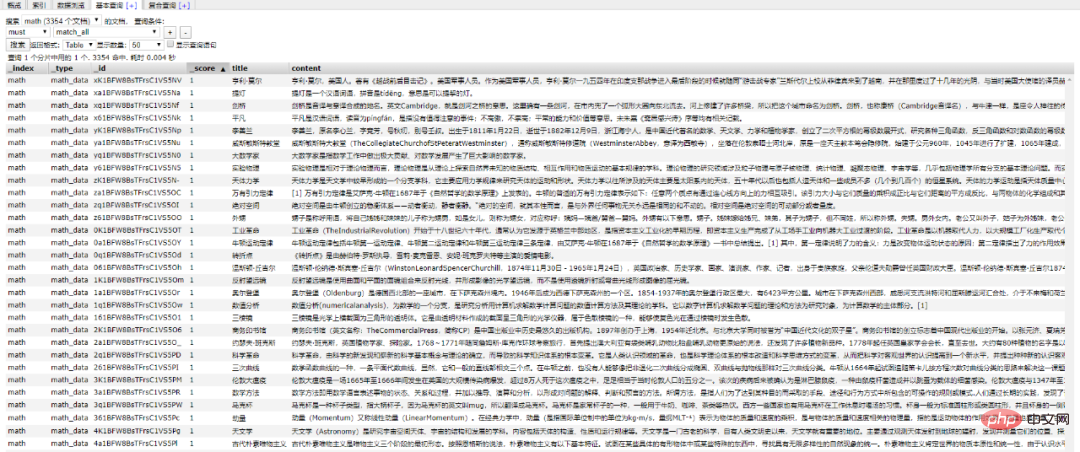Heim >Backend-Entwicklung >Python-Tutorial >Bringen Sie Ihnen Schritt für Schritt bei, wie Sie mit Flask eine ES-Suchmaschine erstellen (vorbereitender Teil)
Bringen Sie Ihnen Schritt für Schritt bei, wie Sie mit Flask eine ES-Suchmaschine erstellen (vorbereitender Teil)
- Go语言进阶学习nach vorne
- 2023-07-25 17:27:281246Durchsuche
/1 Vorwort/
Elasticsearch ist eine Open-Source-Suchmaschine, die auf einer Volltextsuchmaschinenbibliothek aufbaut Apache Lucene™ Basierend auf den Grundlagen.

Elasticsearch und. Pyth am Das Andocken von ist für uns zu einem Problem geworden (warum haben wir das? um alles zu verbinden? Python bezogen). /2 Python-Interaktion/ Also, Python Es stellt außerdem Abhängigkeitsbibliotheken bereit, die mit Elasticsearch verbunden werden können . Initialisieren Sie eine Verbindung zu einem Elasticsearch Operationsobjekt. Der Standardport ist 9200 Bitte stellen Sie vor der Initialisierung sicher, dass die lokale Umgebung von Elasticsearch eingerichtet wurde. Dokumentdaten basierend auf der ID abrufen 插入文档数据 搜索文档数据 删除文档数据 好啊,封装 search 类也是为了方便调用,整体贴一下。 尝试一下把 Mongodb 中的数据插入到 ES 中。 到 ES 中查看一下,启动 elasticsearch-head 插件。 如果是 npm 安装的那么 cd 到根目录之后直接 npm run start 就跑起来了。 本地访问 http://localhost:9100/ 发现新加的 spider 数据文档确实已经进去了。 /3 爬虫入库/ 要想实现 ES 搜索,首先要有数据支持,而海量的数据往往来自爬虫。 为了节省时间,编写一个最简单的爬虫,抓取 百度百科。 简单粗暴一点,先 递归获取 很多很多的 url 链接 把全部 url 存到 url.txt 文件中之后,然后启动任务。 run.py 飞起来 黑窗口键入 哦豁 !! 你居然使用了 Celery 任务队列,gevent 模式,-c 就是10个线程刷刷刷就干起来了,速度杠杠的 !! 啥?分布式? 那就加多几台机器啦,直接把代码拷贝到目标服务器,通过 redis 共享队列协同多机抓取。 这里是先将数据存储到了 MongoDB 上(个人习惯),你也可以直接存到 ES 中,但是单条单条的插入速度堪忧(接下来会讲到优化,哈哈)。 使用前面的例子将 Mongo 中的数据批量导入到 ES 中,OK !!! 到这一个简单的数据抓取就已经完毕了。 好啦,现在 ES 中已经有了数据啦,接下来就应该是 Flask web 的操作啦,当然,Django,FastAPI 也很优秀。嘿嘿,你喜欢 !! 关于FastAPI 的文章可以看这个系列文章: 1、(入门篇)简析Python web框架FastAPI——一个比Flask和Tornada更高性能的API 框架 2、(进阶篇)Python web框架FastAPI——一个比Flask和Tornada更高性能的API 框架 3、(完结篇)Python web框架FastAPI——一个比Flask和Tornada更高性能的API 框架 /4 Flask 项目结构/ 这样一来前期工作就差不多了,接下来剩下的工作主要集中于 Flask 的实际开发中,蓄力中 !!pip install elasticsearch
def __init__(self, index_type: str, index_name: str, ip="127.0.0.1"):
# self.es = Elasticsearch([ip], http_auth=('username', 'password'), port=9200)
self.es = Elasticsearch("localhost:9200")
self.index_type = index_type
self.index_name = index_namedef get_doc(self, uid):
return self.es.get(index=self.index_name, id=uid)def insert_one(self, doc: dict):
self.es.index(index=self.index_name, doc_type=self.index_type, body=doc)
def insert_array(self, docs: list):
for doc in docs:
self.es.index(index=self.index_name, doc_type=self.index_type, body=doc)def search(self, query, count: int = 30):
dsl = {
"query": {
"multi_match": {
"query": query,
"fields": ["title", "content", "link"]
}
},
"highlight": {
"fields": {
"title": {}
}
}
}
match_data = self.es.search(index=self.index_name, body=dsl, size=count)
return match_data
def __search(self, query: dict, count: int = 20): # count: 返回的数据大小
results = []
params = {
'size': count
}
match_data = self.es.search(index=self.index_name, body=query, params=params)
for hit in match_data['hits']['hits']:
results.append(hit['_source'])
return resultsdef delete_index(self):
try:
self.es.indices.delete(index=self.index_name)
except:
passfrom elasticsearch import Elasticsearch
class elasticSearch():
def __init__(self, index_type: str, index_name: str, ip="127.0.0.1"):
# self.es = Elasticsearch([ip], http_auth=('elastic', 'password'), port=9200)
self.es = Elasticsearch("localhost:9200")
self.index_type = index_type
self.index_name = index_name
def create_index(self):
if self.es.indices.exists(index=self.index_name) is True:
self.es.indices.delete(index=self.index_name)
self.es.indices.create(index=self.index_name, ignore=400)
def delete_index(self):
try:
self.es.indices.delete(index=self.index_name)
except:
pass
def get_doc(self, uid):
return self.es.get(index=self.index_name, id=uid)
def insert_one(self, doc: dict):
self.es.index(index=self.index_name, doc_type=self.index_type, body=doc)
def insert_array(self, docs: list):
for doc in docs:
self.es.index(index=self.index_name, doc_type=self.index_type, body=doc)
def search(self, query, count: int = 30):
dsl = {
"query": {
"multi_match": {
"query": query,
"fields": ["title", "content", "link"]
}
},
"highlight": {
"fields": {
"title": {}
}
}
}
match_data = self.es.search(index=self.index_name, body=dsl, size=count)
return match_dataimport json
from datetime import datetime
import pymongo
from app.elasticsearchClass import elasticSearch
client = pymongo.MongoClient('127.0.0.1', 27017)
db = client['spider']
sheet = db.get_collection('Spider').find({}, {'_id': 0, })
es = elasticSearch(index_type="spider_data",index_name="spider")
es.create_index()
for i in sheet:
data = {
'title': i["title"],
'content':i["data"],
'link': i["link"],
'create_time':datetime.now()
}
es.insert_one(doc=data)
import requests
import re
import time
exist_urls = []
headers = {
'User-Agent': 'Mozilla/5.0 (Windows NT 6.1) AppleWebKit/537.36 (KHTML, like Gecko) Chrome/62.0.3202.62 Safari/537.36',
}
def get_link(url):
try:
response = requests.get(url=url, headers=headers)
response.encoding = 'UTF-8'
html = response.text
link_lists = re.findall('.*?<a target=_blank href="/item/([^:#=<>]*?)".*?</a>', html)
return link_lists
except Exception as e:
pass
finally:
exist_urls.append(url)
# 当爬取深度小于10层时,递归调用主函数,继续爬取第二层的所有链接
def main(start_url, depth=1):
link_lists = get_link(start_url)
if link_lists:
unique_lists = list(set(link_lists) - set(exist_urls))
for unique_url in unique_lists:
unique_url = 'https://baike.baidu.com/item/' + unique_url
with open('url.txt', 'a+') as f:
f.write(unique_url + '\n')
f.close()
if depth < 10:
main(unique_url, depth + 1)
if __name__ == '__main__':
start_url = 'https://baike.baidu.com/item/%E7%99%BE%E5%BA%A6%E7%99%BE%E7%A7%91'
main(start_url)# parse.py
from celery import Celery
import requests
from lxml import etree
import pymongo
app = Celery('tasks', broker='redis://localhost:6379/2')
client = pymongo.MongoClient('localhost',27017)
db = client['baike']
@app.task
def get_url(link):
item = {}
headers = {'User-Agent':'Mozilla/5.0 (Macintosh; Intel Mac OS X 10_9_2) AppleWebKit/537.36 (KHTML, like Gecko) Chrome/34.0.1847.131 Safari/537.36'}
res = requests.get(link,headers=headers)
res.encoding = 'UTF-8'
doc = etree.HTML(res.text)
content = doc.xpath("//div[@class='lemma-summary']/div[@class='para']//text()")
print(res.status_code)
print(link,'\t','++++++++++++++++++++')
item['link'] = link
data = ''.join(content).replace(' ', '').replace('\t', '').replace('\n', '').replace('\r', '')
item['data'] = data
if db['Baike'].insert(dict(item)):
print("is OK ...")
else:
print('Fail')from parse import get_url
def main(url):
result = get_url.delay(url)
return result
def run():
with open('./url.txt', 'r') as f:
for url in f.readlines():
main(url.strip('\n'))
if __name__ == '__main__':
run()celery -A parse worker -l info -P gevent -c 10


Das obige ist der detaillierte Inhalt vonBringen Sie Ihnen Schritt für Schritt bei, wie Sie mit Flask eine ES-Suchmaschine erstellen (vorbereitender Teil). Für weitere Informationen folgen Sie bitte anderen verwandten Artikeln auf der PHP chinesischen Website!
In Verbindung stehende Artikel
Mehr sehen- Flask- und Sublime Text-Integration: Tipps zur Entwicklung von Python-Webanwendungen (Teil 6)
- Tipps zur Leistungsoptimierung in Flask-Anwendungen
- Flask-Cors: Lösung domänenübergreifender Probleme in Python-Webanwendungen
- Python-Serverprogrammierung: Erstellen einer RESTful-API mit Flask
- Python-Serverprogrammierung: Verwendung von Flask-Login zur Implementierung der Benutzeranmeldung

